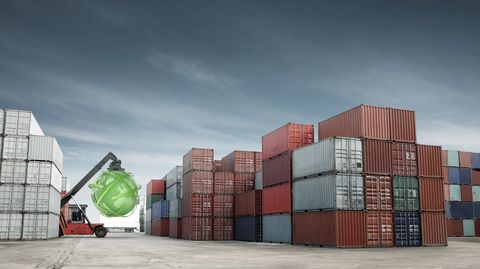Intrastat Reporting
Overview
Any firm trading within the borders of the EU will need to be aware of Intrastat reporting requirements for trade taking place between countries within the bloc.
In operation since the creation of the Single Market in 1993, which removed customs checks at internal borders within the EU, the system requires businesses importing and exporting goods between different EU member states to make Intrastat declarations providing information about their goods.
Despite of a consistent EU-wide regulation for Intrastat (system for collecting information and producing statistics related to the trade in goods between the countries of the EU), companies need to report to all different national authority systems in all EU member states. This is a tremendous challenge especially for multinational companies.
MIC INTRA is the only available software package which offers an efficient and economical solution for Intrastat declarations in all EU member states. In addition MIC INTRA supports the automatic conversion of Intrastat dispatches of the country of dispatch into country-specific declaration formats for Intrastat arrivals of the recipient country, resulting in a reduction of system interfaces and minimization of manual interference.
What is Intrastat reporting used for?
Intrastat is used for statistical purposes to ensure national governments maintain visibility into intra-EU trade and is one of the most important sources of data on the movement of goods within the EU member states.
It is used by governments to monitor industrial performance and set trade policies by providing detailed information about markets. The data compiled via the system is utilized by organizations including ministries of finance, the European Commission, the European Central Bank, national banks, export councils, business and industrial organizations and research institutions.
Intrastat reporting is not directly related to tax declarations made at EU level. Therefore, this mechanism is enforced through local legislation in each EU member state. Non-compliance with Intrastat reporting requirements can result in criminal proceedings, with liability on a company's directors.
Making Intrastat declarations
Each member state has its own format for making Intrastat declarations, with details usually sent directly to national statistical authorities. There can be a range of differences between countries in how and when reporting is required, so it is vital for importers and exporters to ensure they are fully familiar with the local rules in every country in which they do business.
Intrastat reporting is typically done on a monthly basis, with filings usually undertaken at the same time as VAT returns, though exact dates differ from country to country.
Intrastat reporting thresholds
All member states set their own thresholds at which companies are required to make Intrastat declarations. This is based on the annual value of goods and is typically higher than VAT thresholds.
However, reporting thresholds for arrivals and departures differ between nations, which may mean the same goods could be required to make an arrival declaration, but not a departure declaration, or vice-versa, depending on the national thresholds in place in their countries of origin and destination.
Who is required to make Intrastat declarations?
Intrastat declarations must be submitted in the member state from which the goods are physically dispatched (departure reporting) and in the member state the goods physically enter (arrival reporting). Suppliers submit dispatch declarations and purchasers submit arrivals declarations.
Information is required on most transactions that involve movement of EU goods from one EU member state to another. These are defined as:
- Goods obtained entirely within the EU
- Goods from countries outside the EU that are put into free circulation in the EU
- Goods that are a combination of the above
There are a number of exemptions that apply to Intrastat reporting. As well as goods that don't meet the required value thresholds, there are a number of specific exclusions to the reporting rules, including (but not limited to) goods for repair or temporary use, software and services, means of payment such as legal tender, and goods moving between EU member states and certain enclaves, embassies or military facilities.
Intrastat declaration required information
Typically, an Intrastat declaration is required to include the following information:
- Commodity codes and CN8s
- Member state of arrival
- Member state of departure
- Country of origin
- Quantity and value of the goods
- A brief description of the goods
- Mode of transportation, including any shipping costs
- Delivery terms
The format of these declarations is designated by the statistical authorities in each member state. Many countries require this information to be submitted electronically, but paper forms may be used in some states.
Intrastat departure reporting
Intrastat departure declarations must be made by the supplier of the goods in the region of origin. This refers to the member state of dispatch where the goods were produced, manufactured, assembled, processed, repaired or maintained.
If the initial region of origin is outside the EU, the departure country is regarded as the region where the goods were dispatched, or where commercial processes took place.
Intrastat arrival reporting
Intrastat arrival declarations are required to be made by the purchaser in the EU member state where the goods are to be consumed, assembled, processed, repaired, constructed or maintained.
Some goods may enter one or more member states in transit before reaching the final destination where they are subject to stops or legal operations not directly related to their transport, such as a change of ownership. In this case, the member state of arrival will be deemed to be the last EU member state where such operations occurred.
Northern Ireland - a special case
While the Intrastat system is usually only used for trade within the borders of the EU, there is one notable exception, which is goods traveling to or from Northern Ireland (NI).
This is because, under the terms of the Northern Ireland protocol agreed as part of the Brexit deal between the EU and UK, this region remains effectively part of the EU Single Market and as such is subject to the Intrastat systems.
The process began as of 1st January 2021 and will continue for the duration of the Northern Ireland protocol - expected to be a minimum of four years.
The annual thresholds for Northern Ireland goods are £1,500,000 for EU imports (arrivals) and £250,000 for EU exports (dispatches), and Intrastat declarations must be made for the following items:
- Goods imported into NI from the EU
- Goods exported from NI to the EU
These declarations must be made to HMRC regardless of where businesses themselves are based (including firms based in the rest of the UK). However, companies do not have to submit Intrastat declarations for goods exported from Great Britain to the EU, nor for goods imported from the EU to Great Britain as of January 1st 2022.
The MIC Inrastat reporting solution for all EU member states
- Developed for a quick roll-out in all EU countries
- Reduces the number of interfaces and improves data quality by automatic conversion of intercompany shipment data into arrival data for the destination country, taking national codes and data determination logics into consideration as well
- One central installation supporting at the same time local and national activities and requirements
- Takes company-internal regulations into account
- Supports the control of the national VAT statements
- Interface for CN8 data feed for all EU member states via MIC GTCS (Global Trade Content Service)
- Transparency through complete automation and centralization for preparation of Intrastat declarations using standard interfaces and standard processes
- Reduced effort for preparation of monthly declarations
- Optimized local Intrastat processes
One contact only
for all EU member states
Automatic conversion
of intercompany supplies into arrivals for the recipient country
Reduction of interfaces
saves costs and time


